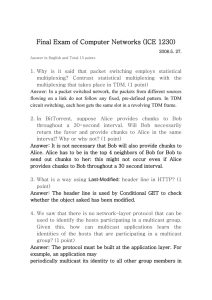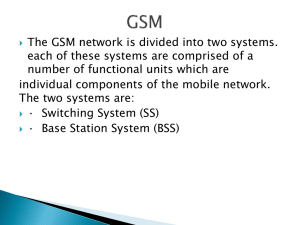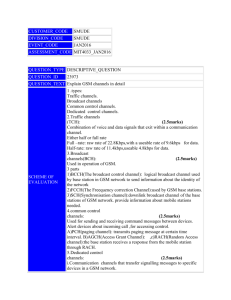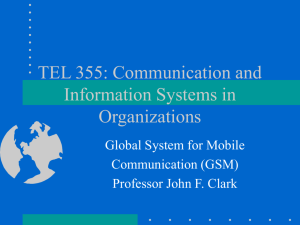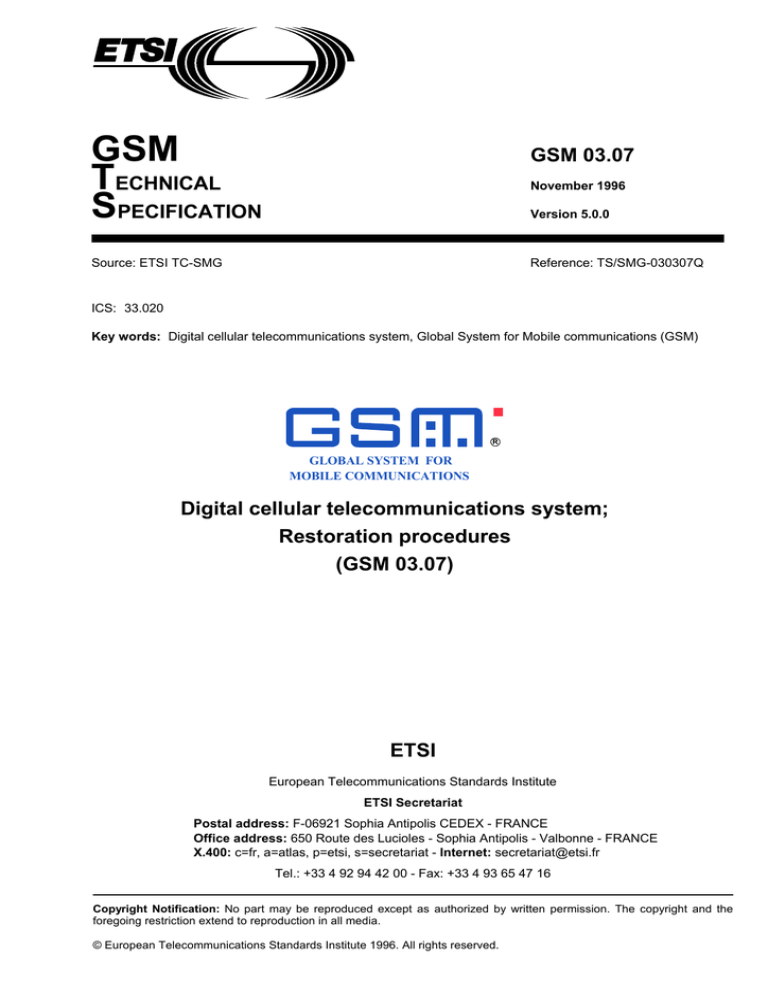
GSM
TECHNICAL
SPECIFICATION
GSM 03.07
November 1996
Version 5.0.0
Source: ETSI TC-SMG
Reference: TS/SMG-030307Q
ICS: 33.020
Key words: Digital cellular telecommunications system, Global System for Mobile communications (GSM)
R
GLOBAL SYSTEM FOR
MOBILE COMMUNICATIONS
Digital cellular telecommunications system;
Restoration procedures
(GSM 03.07)
ETSI
European Telecommunications Standards Institute
ETSI Secretariat
Postal address: F-06921 Sophia Antipolis CEDEX - FRANCE
Office address: 650 Route des Lucioles - Sophia Antipolis - Valbonne - FRANCE
X.400: c=fr, a=atlas, p=etsi, s=secretariat - Internet: secretariat@etsi.fr
Tel.: +33 4 92 94 42 00 - Fax: +33 4 93 65 47 16
Copyright Notification: No part may be reproduced except as authorized by written permission. The copyright and the
foregoing restriction extend to reproduction in all media.
© European Telecommunications Standards Institute 1996. All rights reserved.
Page 2
GSM 03.07 version 5.0.0: November 1996
Whilst every care has been taken in the preparation and publication of this document, errors in content,
typographical or otherwise, may occur. If you have comments concerning its accuracy, please write to
"ETSI Editing and Committee Support Dept." at the address shown on the title page.
Page 3
GSM 03.07 version 5.0.0: November 1996
Contents
Foreword .......................................................................................................................................................5
1
Scope ..................................................................................................................................................7
1.1
Normative references ..........................................................................................................7
1.2
Abbreviations .......................................................................................................................8
2
Design objectives ................................................................................................................................8
3
Restoration indicators in location registers..........................................................................................8
3.1
Restoration Indicators in the VLR ........................................................................................8
3.2
Restoration Indicators in the HLR ........................................................................................9
4
Restoration of data in the VLR ............................................................................................................9
4.1
Restart of the VLR ...............................................................................................................9
4.2
Restoration Procedures .......................................................................................................9
4.2.1
Incoming Call.................................................................................................10
4.2.2
Mobile Terminated Short Message ...............................................................11
4.2.3
Outgoing MS request ....................................................................................12
4.2.4
Location Updating or IMSI Attach..................................................................12
4.2.5
Use of TMSI ..................................................................................................12
5
Restoration of data in the HLR ..........................................................................................................13
5.1
Restart of the HLR .............................................................................................................13
5.2
Procedures During Restoration .........................................................................................13
5.2.1
Mobile terminated call ...................................................................................13
5.2.2
Mobile Originated Activity ..............................................................................14
6
Periodic location updating .................................................................................................................14
7
Stand-alone operation of the VLR .....................................................................................................14
History..........................................................................................................................................................15
Page 4
GSM 03.07 version 5.0.0: November 1996
Blank page
Page 5
GSM 03.07 version 5.0.0: November 1996
Foreword
This Global System for Mobile communications Technical Specification (GTS) has been produced by the
Special Mobile Group (SMG) Technical Committee (TC) of the European Telecommunications Standards
Institute (ETSI).
This GTS defines the restoration procedure within the digital cellular telecommunications system.
The contents of this GTS are subject to continuing work within TC-SMG and may change following formal
TC-SMG approval. Should TC-SMG modify the contents of this GTS it will then be republished by ETSI
with an identifying change of release date and an increase in version number as follows:
Version 5.x.y
where:
y
x
the third digit is incremented when editorial only changes have been incorporated in the
specification;
the second digit is incremented for all other types of changes, i.e. technical enhancements,
corrections, updates, etc.
Page 6
GSM 03.07 version 5.0.0: November 1996
Blank page
Page 7
GSM 03.07 version 5.0.0: November 1996
1
Scope
The data stored in location registers are automatically updated in normal operation; the main information
stored in a location register defines the location of each mobile station and the subscriber data required to
handle traffic for each mobile subscriber. The loss or corruption of these data will seriously degrade the
service offered to mobile subscribers; it is therefore necessary to define procedures to limit the effects of
failure of a location register, and to restore the location register data automatically. This Global System for
Mobile communications Technical Specification (GTS) defines the necessary procedures.
The basic principle is that restoration should be based on radio contact to avoid faulty data being spread
in the system.
Subscriber data for supplementary services must also be correctly restored, although the impact on
service of corruption of supplementary service data is less severe.
Procedures for supporting these functions are defined in GSM 09.02.
The MAP operation "IMSI Attach" is used only in MAP version 1; in MAP version 2 the same function is
performed by the MAP operation "Update Location Area". References in this specification to IMSI attach
apply only to MAP version 1 network entities.
If the restoration of subscriber data in the VLR is triggered by Location Updating or IMSI Attach, the VLR
retrieves subscriber data from the HLR by sending an "Update Location" request, which triggers one or
more "Insert Subscriber Data" operations from the HLR. The "Update Location" request may also be used
to send the LMSI to the HLR.
If the restoration of subscriber data in the VLR is triggered by a "Provide Roaming Number" request, the
behaviour of the VLR depends on whether it is implemented according to MAP version 1 or MAP
version 2. For MAP version 2, the VLR retrieves subscriber data from the HLR by sending a "Restore
Data" request, which triggers one or more "Insert Subscriber Data" operations from the HLR. The
"Restore Data" request is also used to send the LMSI to the HLR. For MAP version 1, the VLR retrieves
subscriber data from the HLR by sending a "Send Parameters" request with parameter type "Subscriber
Data", which cannot be used to send the LMSI to the HLR.
The VLR number and MSC number in the subscriber data in the HLR are updated by the "Update
Location" procedure.
1.1
Normative references
This GTS incorporates by dated and undated reference, provisions from other publications. These
normative references are cited at the appropriate places in the text and the publications are listed
hereafter. For dated references, subsequent amendments to or revisions of any of these publications
apply to this GTS only when incorporated in it by amendment or revision. For undated references, the
latest edition of the publication referred to applies.
[1]
GSM 01.04 (ETR 350): "Digital cellular telecommunications system (Phase 2+);
Abbreviations and acronyms".
[2]
GSM 03.05 (ETR 351): "Digital cellular telecommunications system Technical
performance objectives".
[3]
GSM 03.22 (ETS 300 930): "Digital cellular telecommunications system;
Functions related to Mobile Station (MS) in idle mode and group receive mode".
[4]
GSM 03.40 (ETS 300 901): "Digital cellular telecommunications system
(Phase 2+); Technical realization of the Short Message Service (SMS)
Point-to-Point (PP)".
[5]
GSM 09.02 (ETS 300 974): "Digital cellular telecommunications
(Phase 2+); Mobile Application Part (MAP) specification".
system
Page 8
GSM 03.07 version 5.0.0: November 1996
[6]
1.2
GSM 12.07 (ETS 300 612-3): "Digital cellular telecommunications system
(Phase 2); Operations and performance management".
Abbreviations
Abbreviations used in this GTS are listed in GSM 01.04.
2
Design objectives
To avoid loss of all the data stored in a location register when part of the equipment of the location register
fails, a regime must be implemented to secure the data. This regime can include replication of volatile
storage units and periodic back-up of data to non-volatile storage. If the data security regime ensures the
integrity of the data in spite of failure of part of the location register equipment then there will be no impact
on service. This Technical Specification describes the procedures to be used when the integrity of data in
the location register cannot be ensured; that situation is referred to below as "failure".
The VLR shall erase all IMSI records affected by the failure when it restarts after a failure.
For the HLR, periodic back-up of data to non-volatile storage is mandatory.
The reliability objectives of location registration are listed in GSM 03.05 and GSM 12.07.
3
3.1
Restoration indicators in location registers
Restoration Indicators in the VLR
Three restoration indicators are provided in the VLR for each IMSI record: "Confirmed by Radio Contact",
"Subscriber Data Confirmed by HLR" and "Location Information Confirmed in HLR".
The indicator "Confirmed by Radio Contact" indicates whether the VLR's record of location area identity
and MSC number for the mobile station is confirmed by radio contact.
The indicator "Confirmed by Radio Contact" in an IMSI record is set to the initial value "Not Confirmed"
when the VLR receives a "Provide Roaming Number" request, an "Update Location Area" request or an
"IMSI Attach" request for an MS for which the VLR does not have an IMSI record.
The indicator "Confirmed by Radio Contact" is set to "Confirmed" when the radio contact that has been
established with the MS is authenticated.
The indicator "Subscriber Data Confirmed by HLR" indicates whether the subscriber data set for the
mobile station held by the VLR is consistent with that held by the HLR.
The indicator "Subscriber Data Confirmed by HLR" is set to the initial value "Not Confirmed" when the VLR
receives a "Provide Roaming Number" request, an "Update Location Area" request or an "IMSI Attach"
request for an MS for which the VLR does not have an IMSI record.
The indicator "Subscriber Data Confirmed by HLR" is set to "Confirmed" at either of the following events:
-
The VLR successfully performs an "Update Location" to the HLR;
The VLR successfully performs a "Restore Data" operation to the HLR.
The indicator "Location Information Confirmed in HLR" indicates whether the HLR's record of VLR number
and MSC number for the mobile station is confirmed by radio contact.
The indicator "Location Information Confirmed in HLR" is set to "Not Confirmed" at any of the following
events:
-
The VLR receives an "Update Location Area" request or an IMSI Attach" request for an MS for
which the VLR has no IMSI record;
-
A VLR which serves two or more MSCs receives a "Provide Roaming Number" request for an MS
for which the VLR has no IMSI record;
Page 9
GSM 03.07 version 5.0.0: November 1996
-
The VLR receives a "Reset" message from the HLR with which the MS is registered.
The indicator "Location Information Confirmed in HLR" is set to "Confirmed" at either of the following
events:
-
A VLR which serves only one MSC receives a "Provide Roaming Number" request for an MS for
which the VLR has no IMSI record;
-
Successful completion of the "Update Location" procedure triggered by authenticated radio contact.
3.2
Restoration Indicators in the HLR
As an implementation option, one restoration indicator may be provided in the HLR for each IMSI record:
"Check SS".
The "Check SS" indicator is set to "Check Required" when the HLR restarts after a failure.
The "Check SS" indicator is checked whenever the HLR receives an "Update Location" request from a
VLR. If it is set to "Check Required", after successful completion of subscriber data retrieval that ran
embedded in the "Update Location" procedure the HLR sends a "Forward Check SS Indication" request
message to the VLR and sets the "Check SS" indicator to "Check Not Required".
4
Restoration of data in the VLR
The effect on service of failure of a VLR is different from the effect of failure of an HLR. The procedures
for restoration of a VLR and an HLR are therefore different.
4.1
Restart of the VLR
When a VLR restarts after a failure, all IMSI records affected by the failure are erased.
There will be no subscriber data or location information stored for an affected mobile station until after the
VLR has received either a "Provide Roaming Number" request or an "Update location Area" request for
that mobile station.
The VLR causes all affected TMSIs and all affected LMSIs to become invalid. "Invalid" in this context
means that the TMSI and LMSI can no longer be regarded as accurate. The term is used to avoid
unnecessary constraints on the implementation.
On receipt of either a "Provide Roaming Number" request or an "Update Location Area" request,
restoration of subscriber data in the VLR is triggered individually for each IMSI record as described below.
4.2
Restoration Procedures
The objective of the restoration procedure is to handle all traffic for each mobile subscriber correctly. In
order to meet this objective, the procedure must make the subscriber data in the VLR consistent with that
in the HLR, and make the location information in the HLR and VLR reflect accurately the current location
of the MS.
Page 10
GSM 03.07 version 5.0.0: November 1996
4.2.1
a)
Incoming Call
Send Routing Information (GMSC->HLR)
The HLR sends "Provide Roaming Number" to the VLR as for normal operation. The LMSI is
updated by the VLR when the VLR requests the transfer of subscriber data from the HLR using the
"Restore Data" operation.
b)
c)
d)
Provide Roaming Number (HLR->VLR)
-
Regardless of whether the VLR has an IMSI record corresponding to the IMSI in the "Provide
Roaming Number", it returns an MSRN. If no IMSI record exists, the VLR creates a skeleton
IMSI record, sets the indicators "Subscriber Data Confirmed by Radio Contact" and
"Confirmed by HLR" to "Not Confirmed" and (if IMSI Attach is used) marks the IMSI as
attached. If the VLR serves two or more MSCs, the VLR sets the indicator "Location
Information Confirmed in HLR" to "Not Confirmed". Otherwise, if the VLR serves only one
MSC, the indicator "Location Information Confirmed in HLR" is set to the initial value
"Confirmed".
-
If the indicator "Subscriber Data Confirmed by HLR" is "Not Confirmed" the VLR requests
authentication data, if required and still not available and subscriber data from the HLR.
When the dialogue that covers the subscriber data retrieval procedure is completed
successfully, the VLR sets the indicator "Subscriber Data Confirmed by HLR" to "Confirmed".
The indicators "Confirmed by Radio Contact" and "Location Information Confirmed in HLR"
remain unchanged.
-
If the IMSI record for the MS is marked "Subscriber Data Confirmed by HLR" but "Not
Confirmed by Radio Contact" the operator may choose an appropriate method to limit the
number of "Search for MS" procedures for that MS.
Send Information for I/C Call Setup (MSC->VLR)
-
If the VLR has no IMSI record, or if the record is marked "Subscriber Data Not Confirmed by
HLR" the VLR returns a "System Failure" error.
-
If the VLR has an IMSI record marked "Subscriber Data Confirmed by HLR" and "Not
Confirmed by Radio Contact", the VLR handles the request in the normal way, except that
the "Search for MS" procedure is used instead of the "Page MS" procedure.
-
If the VLR has an IMSI record marked "Subscriber Data Confirmed by HLR" and "Confirmed
by Radio Contact", the VLR handles the request in the normal way; for this MS, VLR
restoration is complete.
-
The state of the indicator "Location Information Confirmed in HLR" does not affect the "Send
Information for I/C Call Setup" procedure.
Process Access Request in Response to Search (MSC->VLR)
-
If the MS responds to paging, the MSC sends a positive response to the search request and
a "Process Access Request" to the VLR. After successful authentication, if required, the VLR
sets the indicator "Confirmed by Radio Contact" to "Confirmed", sets the location area
information for the MS, and handles the request in the normal way.
-
The VLR checks the indicator "Location Information Confirmed in HLR". If it indicates "Not
Confirmed" the VLR starts an "Update Location" procedure to the HLR. When this procedure
is successfully completed the VLR sets the indicator "Location Information Confirmed in
HLR" to "Confirmed".
For this MS, VLR restoration is complete.
Page 11
GSM 03.07 version 5.0.0: November 1996
4.2.2
a)
Mobile Terminated Short Message
Send Routing Information for MT SMS (SMS-GMSC->HLR)
The HLR returns the MSC number as for normal operation.
b)
c)
d)
Send Information for MT SMS (MSC->VLR) - MAP version 2
-
If the VLR has no IMSI record, or if the record is marked "Subscriber Data Not Confirmed by
HLR" the VLR returns an "Unidentified Subscriber" error. This causes the MSC to report a
short message delivery failure, with cause "Unidentified Subscriber", to the SMS gateway
MSC. The Gateway MSC sends a "Report SM Delivery Status" request, with a cause of
"Absent Subscriber", to the HLR. This causes the HLR to set the "Mobile Station Not
Reachable Flag" for the MS, as described in Technical Specifications GSM 03.40 &
GSM 09.02.
-
If the VLR has an IMSI record marked "Subscriber Data Confirmed by HLR" and "Not
Confirmed by Radio Contact", the VLR handles the request in the normal way, except that
the "Search for MS" procedure is used instead of the "Page MS" procedure.
-
If the VLR has an IMSI record marked "Subscriber Data Confirmed by HLR" and "Confirmed
by Radio Contact", the VLR handles the request in the normal way; for this MS, VLR
restoration is complete.
-
The state of the indicator "Location Information Confirmed in HLR" does not affect the "Send
Information for MT SMS" procedure.
Send Information for I/C Call Setup (MSC->VLR) - MAP version 1
-
If the VLR has no IMSI record, or if the record is marked "Subscriber Data Not Confirmed by
HLR" the VLR returns a "System Failure" error. This causes the MSC to report a short
message delivery failure, with cause "System Failure", to the SMS gateway MSC.
-
If the VLR has an IMSI record marked "Subscriber Data Confirmed by HLR" and "Not
Confirmed by Radio Contact", the VLR handles the request in the normal way, except that
the "Search for MS" procedure is used instead of the "Page MS" procedure.
-
If the VLR has an IMSI record marked "Subscriber Data Confirmed by HLR" and "Confirmed
by Radio Contact", the VLR handles the request in the normal way; for this MS, VLR
restoration is complete.
-
The state of the indicator "Location Information Confirmed in HLR" does not affect the "Send
Information for MT SMS" procedure.
Process Access Request in Response to Search (MSC->VLR)
-
If the MS responds to paging, the MSC sends a positive response to the search request and
a "Process Access Request" to the VLR. After successful authentication, if required, the VLR
sets the indicator "Confirmed by Radio Contact" to "Confirmed", sets the location area
information for the MS, and handles the request in the normal way.
-
The VLR checks the indicator "Location Information Confirmed in HLR". If it indicates "Not
Confirmed" the VLR starts an "Update Location" procedure to the HLR. When this procedure
is successfully completed, the VLR sets the indicator "Location Information Confirmed in
HLR" to "Confirmed".
For this MS, VLR restoration is complete.
Page 12
GSM 03.07 version 5.0.0: November 1996
4.2.3
Outgoing MS request
An outgoing request (MS originated call, mobile originated Short Message or call-independent
supplementary service activity) from the MS causes the VLR to check its IMSI record for that MS.
-
If the MS is unknown in this VLR (i.e. the VLR has no IMSI record for the MS) or there is an
IMSI record marked "Subscriber Data Not Confirmed by HLR" the outgoing request is
rejected with error cause "Unidentified Subscriber". This causes the MS to initiate the location
registration procedure described below.
-
If the VLR has an IMSI record for the MS marked "Subscriber Data Confirmed by HLR" the
request is handled in the normal way, and after any necessary authentication and/or IMEI
checking the record is marked "Confirmed by Radio Contact".
-
The VLR checks the indicator "Location Information Confirmed in HLR". If it indicates "Not
Confirmed" the VLR starts an "Update Location" procedure to the HLR. When this procedure
is successfully completed the VLR sets the indicator "Location Information Confirmed in
HLR" to "Confirmed".
For this MS, VLR restoration is complete.
4.2.4
Location Updating or IMSI Attach
A location registration request (location updating or IMSI attach) from an MS causes the VLR to check its
IMSI record for that MS.
-
If the MS is unknown in this VLR (i.e. the VLR has no IMSI record for the MS) the VLR
creates a skeleton IMSI record for the MS and sets the indicators "Confirmed by Radio
Contact", "Location Information Confirmed in HLR" and "Subscriber Data Confirmed by HLR"
to "Not Confirmed". If authentication is required, the VLR retrieves authentication data. When
the radio contact with the Mobile Station is authenticated, the VLR sets the indicator
"Confirmed by Radio Contact" to "Confirmed. The VLR then performs an "Update Location"
to the HLR. If this is successful, the VLR sets the indicators "Location Information Confirmed
in HLR" and "Subscriber Data Confirmed by HLR" to "Confirmed". For this MS, VLR
restoration is complete.
-
If the VLR has an IMSI record for the MS, after successful authentication, if required, the VLR
sets the indicator "Confirmed by Radio Contact" to "Confirmed". If the record is marked
"Location Information Not Confirmed in HLR" or "Subscriber Data Not Confirmed by HLR" the
VLR performs an "Update Location" to the HLR. If this is successful, the VLR sets the
indicators "Location Information Confirmed in HLR" and "Subscriber Data Confirmed by HLR"
to "Confirmed". For this MS, VLR restoration is complete.
4.2.5
Use of TMSI
After the VLR has restarted but before the next authenticated radio contact the TMSI known by the MS is
invalid, as it was allocated before the VLR restarted. The VLR therefore uses the IMSI to identify the MS
on the first radio contact during restoration.
-
A VLR which initiates a "Search for Subscriber" procedure uses the IMSI to identify the MS.
-
If an MS identifies itself by a TMSI in a "Location Registration" request, the VLR proceeds as
follows:
a)
The VLR checks the location area identity (LAI) of the previous location area sent by
the MS. If this LAI is in a VLR different from the current one, the request is handled in
the normal way.
b)
If the LAI is in the current VLR, the status of the TMSI is checked.
If the TMSI was allocated after the VLR restarted, and corresponds to a valid
IMSI record, the request is handled as described in section 4.2.4.
Page 13
GSM 03.07 version 5.0.0: November 1996
5
-
If the TMSI was allocated before the VLR restarted, or does not correspond to a
valid IMSI record, the VLR requests the IMSI from the MS. If the MS returns an
IMSI the VLR proceeds as described in section 4.2.4. If the MS does not return
an IMSI the network aborts the location registration procedure.
-
If an MS identifies itself by a TMSI in an outgoing MS request, the VLR proceeds
as follows:
-
If the TMSI was allocated after the VLR restarted, and corresponds to a valid
IMSI record, the request is handled as described in section 4.2.3.
-
If the TMSI was allocated before the VLR restarted, or does not correspond to a
valid IMSI record, the VLR requests the IMSI from the MS. If the MS returns an
IMSI the VLR proceeds as described in section 4.2.3. If the MS does not return
an IMSI the network aborts the outgoing request.
Restoration of data in the HLR
The loss or corruption of subscriber data in the HLR has an impact not only in the HLR's own PLMN but
also on the service for its mobiles in other PLMNs. Restoration of the data in the HLR requires
co-operation from all the VLRs to which its mobiles have roamed.
5.1
Restart of the HLR
When an HLR restarts after failure it performs the following actions for the subscriber data records that
have been affected by the HLR fault:
5.2
5.2.1
-
Reload all data from the non-volatile back-up;
-
Reset all "MS Purged" flags;
-
Mark each subscriber record "SS Check Required" by setting the "Check SS" indicator if the
"Forward Check SS Indication" service is implemented;
-
Send a "Reset" message to each VLR where one or more of its MSs are registered. This
causes each VLR concerned to mark each relevant subscriber record "Location Information
Not Confirmed in HLR".
Procedures During Restoration
Mobile terminated call
If the VLR receives a "Process Access Request" request in response to a "Page" or "Search for MS"
operation, after successful authentication, if required, it checks the indicator "Location Information
Confirmed in HLR". If this indicates "Not Confirmed" the VLR triggers an "Update Location" to the HLR as
described in section 4.2.1.d).
When the HLR receives the "Update Location" request it stores the VLR number, MSC number and LMSI
in the subscriber record as for normal operation.
If the "Forward Check SS Indication" service is implemented, the HLR checks the indicator "Check SS". If
this indicates "Check Required", after successful completion of the subscriber data retrieval procedure
that ran embedded in the "Update Location" procedure the HLR sends a "Forward Check SS Indication" to
the VLR and marks the subscriber record "Check Not Required. When the VLR receives the "Forward
Check SS Indication" request it forwards an indication to the MS to alert the user that supplementary
service parameters should be checked.
Page 14
GSM 03.07 version 5.0.0: November 1996
5.2.2
Mobile Originated Activity
When the VLR receives a request from an MS (MS originated call, mobile originated Short Message,
call-independent supplementary service activity or location registration request) whose IMSI record is
marked "Location Information Not Confirmed in HLR", it will perform an "Update Location" to the HLR as
described in sections 4.2.3 and 4.2.4 above.
When the HLR receives an "Update Location" request from the VLR, it proceeds as described in
section 5.2.1.
6
Periodic location updating
The time taken to confirm the location of an MS after location register failure is governed by the frequency
with which the MS establishes radio contact with the network. The location information for an MS which
remains silent for a long time will remain doubtful for a long time.
A method of reducing this time is to require the MS to establish radio contact with the network at intervals,
purely to confirm its location, if the MS does not move to a new location area (which would lead to a
normal location registration) or respond to paging for a mobile terminated call or request a mobile
originated call or call-independent supplementary service activity.
The interval between successive periodic location updatings is controlled by a timer in the MS; this timer is
reset to its initial value at the end of each successfully established radio contact between the MS and the
network.
The use of the periodic location update timer is described in GSM 03.22.
7
Stand-alone operation of the VLR
If no unused authentication triplets are available in the VLR for an IMSI record when authentication is
required, the VLR may reuse already used authentication triplets. It is an operator option to define how
many times an authentication triplets may be reused in the VLR.
If the Update Location response contains an error different from "Unknown Subscriber" or "Roaming Not
Allowed" or if there is a parameter problem (e.g. no HLR number included), no error shall be indicated to
the MSC and the IMSI record in the VLR shall not be affected, provided that the associated "Subscriber
Data Confirmed by HLR" indicator is in the "Confirmed" status.
Page 15
GSM 03.07 version 5.0.0: November 1996
History
Document history
November 1996
Publication of version 5.0.0 (based on version 4.3.1)
ISBN 2-7437-1169-8
Dépôt légal : Novembre 1996

